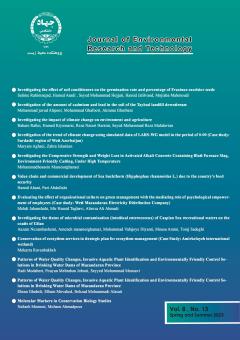-
-
-
Open Access Article
1 - The Study of Solid Waste Management in Rural Healthcare Center (Case Study rural Healthcare Centers of Rasht)
fatemeh ghanbari zeynab bazargard batol sedighiMedical waste is a part of municipal solid waste which is classified as hazardous solid waste. One of the sources of medical waste is rural healthcare centers that are prominent because of having infectious waste. This research aims to study of medical waste in rural he MoreMedical waste is a part of municipal solid waste which is classified as hazardous solid waste. One of the sources of medical waste is rural healthcare centers that are prominent because of having infectious waste. This research aims to study of medical waste in rural healthcare center, the quantity of waste and the method of waste management.This study was done in two countries of Rasht. The method was according to physical analysis and questionnaires.Total amount of medical waste in studied area is 274.3 kg/year. The amount of semi-household waste and medical waste are 75 and 25 percent, respectively. The result of questionnaires indicates lack of solid waste management system in rural healthcare centers of Rasht.The results reveal that the amount of medical waste in studied district is low. This amount is a great deal less than the amount of municipal hospital waste in other research. Although the amount of medical waste is negligible, lack of management system for medical waste separation, storage and disposal will cause undesirable impact on human and their environment. Manuscript profile -
Open Access Article
2 - Environmental effects of sustainable energies (Case Study: Solar, Wind and Hydroelectric Energy)
fatemeh ghanbari farham amin shareIncreasing air pollution and global warming due to the excessive use of fossil fuels attracted public attention to climate change. Accordingly, the expected increase in demand for other alternative energy sources especialy renewable energy is predictable. While some res MoreIncreasing air pollution and global warming due to the excessive use of fossil fuels attracted public attention to climate change. Accordingly, the expected increase in demand for other alternative energy sources especialy renewable energy is predictable. While some research on renewable energy shows that these kind of energy also have undesirable environmental effects. In this study solar energy systems, wind power and hydroelectric power systems wew investigated and their effects on air, soil, sound and effect on wildlife were studied. The results show that although these kind of energy are called clean energy, they have negative environmental effects. This research also suggests ways to prevent the effects of destructive renewable energy sources. Manuscript profile -
Open Access Article
3 - Environmental Impact Assessment of Steel Plant Construction
هانیه میربلوکی niloofar Abedinzade fatemeh ghanbariToday, steel production and consumption is applied as an important criterion for measuring the degree of countries industrial development. Needing to investment in construction and economic infrastructure in developing countries, their steel production policy is in the MoreToday, steel production and consumption is applied as an important criterion for measuring the degree of countries industrial development. Needing to investment in construction and economic infrastructure in developing countries, their steel production policy is in the direction of producing the various types of structural steel. In this regard, the main object of the studied steel plant construction is creating jobs in the region, reducing imports and contributing to the country's economic development through carbon ingot production with electric arc furnace technology. After assigning the direct study area of the project, the major contaminants arising from the project implementation were investigated in construction and implementation phases and the corrective actions considered to reduce the contaminants effects. In this research, Rapid Assessment method was used for environmental impact assesment that according to the results, among 96 detected impacts, 55.1 percent of the impacts are negative and 44.9 percent are positive that in case of observing the corrective actions before and after the project implementation, its negative impacts will be minimized. Also, it is recommended that after the plant costruction, apply a periodic monitoring of the outlet contaminants every three months. Manuscript profile -
Open Access Article
4 - Comparison of the effects of pollution caused by Saravan wastes on Kacha River during drought and wet year
مینا جعفری هانیه میربلوکی fatemeh ghanbariWaste landfills change over time due to exposure to physical and biological factors, these changes include the production of leachate and its penetration into the subsoil, groundwater pollution, production and emission of gases from waste decomposition, and finally the MoreWaste landfills change over time due to exposure to physical and biological factors, these changes include the production of leachate and its penetration into the subsoil, groundwater pollution, production and emission of gases from waste decomposition, and finally the settlement in the site. The leachate produced flows in different layers of waste and carries toxic and polluted substances to surface or groundwater. Kacha River, which carries the contamination load from Saravan landfill, flows into Siahrud River; Siahroud passes through this lands on its way, flows to the north and after joining Goharroud, enters the eastern part of Anzali Wetland. In this study, sampling stations were located in Saravan landfill and Kacha River and sampling was done in winter and summer and COD, BOD, TDS, pH, EC, ammonia, phosphate and nitrate parameters were measured. Comparison of the results of leachate analysis of Saravan landfill and Kacha River in summer and winter showed that all parameters, including BOD and COD parameters, which are indicators of contamination load in the Kacha River, increased in the drought season (summer) compared to the wet season (winter) Which indicates the amount of more pollution from Saravan landfill to Kacha River and from there to Gohar River and finally Anzali wetland. Manuscript profile
List of Articles fatemeh ghanbari
-
The rights to this website are owned by the Raimag Press Management System.
Copyright © 2017-2024


